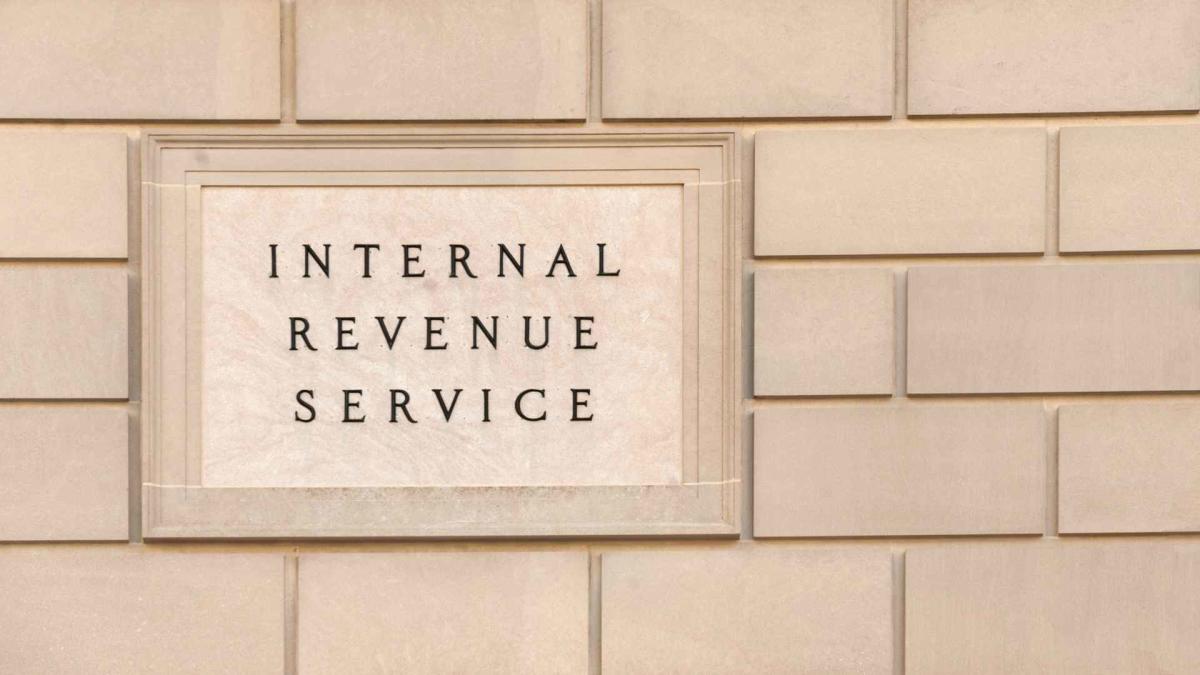Home>Finance>What Happens If You Owe The IRS More Than $25000?


Finance
What Happens If You Owe The IRS More Than $25000?
Published: October 31, 2023
If you owe the IRS more than $25000, find out what happens and how to handle your finances. Expert advice and tips to navigate through tax debt.
(Many of the links in this article redirect to a specific reviewed product. Your purchase of these products through affiliate links helps to generate commission for LiveWell, at no extra cost. Learn more)
Table of Contents
Introduction
Dealing with tax debt can be a daunting and stressful experience. If you find yourself owing the IRS more than $25,000, it’s essential to understand the potential consequences and explore your options for resolving the issue. Ignoring or delaying the payment of tax debt can have serious repercussions, including penalties, interest, and even legal action.
When you owe the IRS a substantial amount of money, it’s crucial to take proactive steps to address the situation. This article will guide you through the process and provide insights into the options available to you.
Before diving into the various solutions, it’s essential to have a firm grasp of tax debt and the role of the Internal Revenue Service (IRS). Tax debt occurs when an individual or business owes money to the IRS because of unpaid taxes, penalties, or interest. The IRS has the authority to collect these outstanding amounts and has several methods to do so.
One of the most significant consequences of owing the IRS over $25,000 is the potential for aggressive collection tactics. The IRS has the power to place a tax lien on your property, garnish your wages, or freeze your bank accounts to recover the outstanding debt. These actions can seriously impact your financial stability and creditworthiness.
To avoid these consequences, it is crucial to explore the options available for resolving tax debt. The IRS offers several programs and agreements that can help you manage your debt and settle with the agency. It’s essential to understand these options and choose the one that best fits your financial situation.
Some of the options available to taxpayers include setting up an installment agreement, filing an offer in compromise, or seeking temporary delaying options such as a currently not collectible status. Additionally, taxpayers may also consider seeking professional help from tax professionals who specialize in resolving tax debt issues.
It’s important to note that owing the IRS a significant amount of money can also result in additional penalties and interest. These penalties can accrue over time, making your financial situation even more challenging. By addressing your tax debt promptly, you can minimize these additional costs and alleviate the burden on your finances.
This article will delve into each of the available options for resolving tax debt when you owe the IRS more than $25,000. By understanding the consequences and exploring the available solutions, you can take the necessary steps to regain control of your finances and work towards resolving your tax debt.
Understanding Tax Debt and the IRS
To effectively address tax debt, it’s crucial to have a clear understanding of what it entails and the role of the Internal Revenue Service (IRS). Tax debt refers to the amount of unpaid taxes, penalties, and interest that an individual or business owes to the IRS.
The IRS is the agency responsible for collecting federal taxes in the United States. They have the authority to enforce tax laws and regulations and ensure that individuals and businesses fulfill their tax obligations. When a taxpayer fails to pay their taxes on time or in full, they become liable for tax debt.
There are several factors that can contribute to the accumulation of tax debt. These can include underpayment or non-payment of estimated taxes, failure to file tax returns, inaccurate reporting of income or deductions, or errors in calculating tax liabilities. Regardless of the reason, it’s important to address tax debt promptly to avoid further complications.
When an individual or business owes the IRS more than $25,000, the agency has the authority to take more aggressive measures to collect the debt. These measures can include placing a tax lien on the taxpayer’s property, garnishing wages, or seizing assets. The IRS may also impose penalties and interest on the outstanding amount, increasing the overall debt.
To avoid these consequences, it’s crucial to take proactive steps to resolve tax debt. The IRS offers various options to help individuals and businesses manage and settle their tax debt. These options include installment agreements, offers in compromise, and temporary delaying options.
An installment agreement allows taxpayers to pay their tax debt in monthly installments over an extended period. This option provides flexibility for those who cannot pay the full amount upfront. However, it’s important to note that interest and penalties may continue to accrue during the installment period.
An offer in compromise is another option available to taxpayers. It allows eligible individuals to settle their tax debt for a reduced amount if they can prove that paying the full debt would cause undue financial hardship. To qualify for an offer in compromise, taxpayers must meet specific criteria and provide detailed financial information to the IRS.
In some cases, taxpayers may qualify for temporary delaying options, such as currently not collectible status. This status suspends collection activities temporarily due to financial hardship. While in this status, the IRS will not actively pursue collection, although interest and penalties may continue to accrue.
It’s important to note that resolving tax debt can be complex, and the IRS has specific guidelines and requirements for each option. Seeking professional help from tax experts who specialize in resolving tax debt issues can provide valuable guidance and ensure the best possible outcome for your specific situation.
By understanding the nature of tax debt and the available options, you can make informed decisions and take the necessary steps to address your tax debt effectively. It’s essential to act proactively and seek appropriate guidance to avoid further complications and regain control of your financial situation.
Consequences of Owning the IRS
Owing the IRS can have serious consequences that can impact various aspects of your life. When you owe the IRS more than $25,000, it’s essential to be aware of these potential repercussions.
One of the immediate consequences of owing a significant amount of tax debt is the potential for aggressive collection tactics by the IRS. The agency has the authority to place a tax lien on your property, which serves as a legal claim against your assets. This can make it difficult to sell or transfer any property you own, as the IRS will have a right to the proceeds to satisfy the outstanding debt.
Furthermore, the IRS can garnish your wages, which means they can legally collect a portion of your income to satisfy the tax debt. This can significantly impact your financial situation, as your take-home pay will be reduced, making it challenging to cover your living expenses and other financial obligations.
In addition to wage garnishment, the IRS can also freeze your bank accounts. This means that they can put a hold on your bank account, preventing you from accessing your funds. This action can cause significant financial strain, impeding your ability to pay for essential expenses and meet financial obligations.
When you owe the IRS over $25,000, it’s important to note that penalties and interest will continue to accrue on the outstanding amount. These additional costs can quickly add up, making it even more challenging to resolve your tax debt. Therefore, it’s crucial to address the issue promptly to minimize these additional charges.
Moreover, owing a substantial amount to the IRS can negatively impact your creditworthiness. The IRS can report your tax debt to credit bureaus, which can result in a lower credit score. This can affect your ability to obtain loans, credit cards, or even secure housing and employment opportunities.
It’s also worth mentioning that the IRS has the authority to take legal action against individuals or businesses with significant tax debt. They can file a lawsuit against you, seeking to obtain a judgment that allows them to collect the debt through various means, such as seizing assets or placing liens on your property.
To avoid these consequences, it is crucial to take proactive steps to address your tax debt. Exploring the available options and working towards a resolution can help in mitigating potential penalties, protecting your assets, and regaining control of your financial situation.
Understanding the consequences of owing the IRS more than $25,000 is essential in motivating individuals and businesses to tackle the issue head-on. By taking timely action and seeking appropriate guidance, you can work towards resolving your tax debt and minimizing the potential impact on your life and finances.
Options for Resolving Tax Debt
When you owe the IRS more than $25,000 in tax debt, it’s important to explore the various options available for resolving the issue. Taking proactive steps to address your tax debt can help you regain control of your financial situation and alleviate the potential consequences. Here are some options to consider:
- Installment Agreement: An installment agreement allows you to pay your tax debt in monthly installments over an extended period. This option is suitable for individuals who cannot pay the full amount upfront. It’s important to note that interest and penalties may continue to accrue during the installment period, so it’s advised to pay as much as you can to minimize additional costs.
- Offer in Compromise: An offer in compromise is an option to settle your tax debt for a reduced amount if you can prove that paying the full debt would cause undue financial hardship. To qualify for an offer in compromise, you must meet specific criteria and provide detailed financial information to the IRS. It’s crucial to carefully assess your financial situation and consult with tax professionals before pursuing this option.
- Temporary Delaying Options: If you’re experiencing financial hardship, you may qualify for temporary delaying options. One such option is currently not collectible (CNC) status, which suspends collection activities temporarily. While in CNC status, the IRS will not pursue collection, although interest and penalties may continue to accrue. This provides temporary relief and allows you to stabilize your financial situation before exploring other options.
- Seeking Professional Help: Resolving tax debt can be complex, and seeking professional help from tax experts who specialize in resolving tax debt issues can provide valuable guidance. Tax professionals can assist in assessing your financial situation, navigating through the available options, and negotiating with the IRS on your behalf. This can increase the chances of reaching a favorable resolution.
It’s crucial to carefully evaluate your financial situation and assess which option suits your circumstances best. Consider factors such as your income, expenses, and the ability to pay off the debt within a reasonable time frame. Seeking guidance from tax professionals can provide clarity and ensure you make informed decisions.
It’s important to note that the IRS has specific guidelines and requirements for each option. It’s essential to be diligent in meeting these requirements and fulfilling your obligations under the chosen resolution option. Failure to comply with the agreed terms can result in the nullification of the agreement, leading to further consequences.
By taking the necessary steps to explore and implement the appropriate option for resolving your tax debt, you can work towards finding a manageable solution and alleviating the financial burden. Addressing tax debt in a proactive manner demonstrates your commitment to fulfilling your obligations and can provide a path towards regaining control of your financial well-being.
Installment Agreement
An installment agreement is a common option offered by the IRS for individuals who owe tax debt of more than $25,000. This arrangement allows you to pay off your tax debt in monthly installments over an extended period of time. It provides flexibility for those who cannot pay the full amount owed upfront.
When setting up an installment agreement, there are several important factors to consider:
- Payment Terms: The IRS will determine the amount you need to pay each month, taking into account your financial situation, including your income, expenses, and assets. It’s important to provide accurate and up-to-date financial information to ensure a fair arrangement.
- Duration: The duration of the installment agreement will depend on the total amount of tax debt owed and your ability to pay. In some cases, the IRS may require full payment within a specific timeframe. In other situations, the installment agreement could extend for several years.
- Interest and Penalties: It’s important to note that interest and penalties will continue to accrue during the installment period. This can increase the overall amount you owe. Paying as much as you can upfront or making larger monthly payments can help minimize these additional costs.
- Payment Methods: You have several options for making payments, including online payments, direct debit from your bank account, or mailing in a check. The IRS encourages electronic payments for their convenience and to ensure timely processing.
When entering into an installment agreement, it’s crucial to comply with its terms and make your payments on time. Failure to adhere to the installment agreement can result in default, leading to additional penalties and the IRS taking more aggressive collection actions.
If you experience financial hardship and can’t meet the terms of the original installment agreement, you may be able to modify it. However, it’s important to communicate with the IRS as soon as possible to discuss your situation and find a suitable solution to avoid any negative consequences.
If you believe an installment agreement is the right option for you, it’s recommended to seek professional advice from tax experts who can help negotiate the terms and ensure the agreement aligns with your financial capabilities. They can provide guidance on the best strategies for managing your tax debt and minimizing the impact of interest and penalties.
Remember, an installment agreement is an opportunity to gradually pay off your tax debt while maintaining financial stability. By fulfilling your obligations under the agreement, you can regain control of your finances and work towards resolving your tax debt effectively.
Offer in Compromise
An offer in compromise (OIC) is an option offered by the IRS for individuals who owe tax debt of more than $25,000 and are unable to pay the full amount. It allows eligible taxpayers to settle their tax debt for a reduced amount that is considered reasonable and can be paid without causing undue financial hardship.
When considering an offer in compromise, it’s important to understand the following key aspects:
- Qualification: To be eligible for an offer in compromise, you must meet certain criteria established by the IRS. These criteria generally include demonstrating that you are unable to pay the full tax debt, providing accurate and detailed financial information, and being compliant with all tax filings and payments.
- Reasonable Collection Potential (RCP): The IRS assesses your ability to pay the tax debt through a calculation known as the reasonable collection potential (RCP). This calculation takes into account your income, expenses, assets, and future earning potential. The IRS uses the RCP to determine the amount they will accept as a compromise.
- Offer Amount: When submitting an offer in compromise, you propose an amount that you believe is a fair and reasonable compromise to settle your tax debt. This amount should be based on your financial situation and the RCP calculation. It’s crucial to provide supporting documentation and a detailed explanation of your offer amount.
- Payment Options: You have two payment options for an offer in compromise. The first is a lump-sum cash offer where you make a one-time payment to settle the debt. The second option is a periodic payment offer, where you make regular payments over a specified period, usually within 24 months.
It’s important to note that the offer in compromise process can be complex, and the IRS evaluates each case on an individual basis. Providing accurate and complete financial information, including income, expenses, assets, and liabilities, is crucial to increase the chances of acceptance.
It’s highly recommended to seek professional assistance when pursuing an offer in compromise. Tax professionals who specialize in resolving tax debt issues can guide you through the process, help you prepare a compelling offer, and negotiate with the IRS on your behalf. They can ensure that you present a strong case and maximize your chances of a successful outcome.
While an offer in compromise can be an attractive option for reducing your tax debt, it’s important to understand that the IRS may still refuse or counteroffer your proposed amount. If your offer is rejected, you have the option to appeal the decision or consider other alternatives for resolving your tax debt.
Ultimately, an offer in compromise can provide a fresh start for individuals burdened by tax debt. It allows you to settle your tax debt for a reduced amount and move forward towards regaining financial stability. By seeking professional guidance, you can navigate the offer in compromise process confidently and increase the chances of a successful resolution.
Temporary Delaying Options
When facing tax debt of more than $25,000, temporary delaying options can provide some relief while you work towards resolving your financial situation. These options can help alleviate the immediate burden of tax debt and provide temporary breathing room. Here are a few temporary delaying options to consider:
- Currently Not Collectible (CNC) Status: If you are experiencing financial hardship and cannot afford to pay your tax debt, you may qualify for currently not collectible status. This status temporarily suspends collection activities by the IRS. However, it’s important to note that interest and penalties may continue to accrue during this period. The IRS will regularly review your financial situation to determine if you still qualify for CNC status.
- Extension of Time to Pay: If you need more time to pay your tax debt, you may request an extension of time to pay from the IRS. This option allows you to delay payment for a specific period. However, interest and penalties will continue to accrue until the full amount is paid.
- Partial Payment Installment Agreement (PPIA): A partial payment installment agreement is an option where you make reduced monthly payments based on your ability to pay. This option is suitable if you cannot afford to pay the full tax debt. Similar to other installment agreements, interest and penalties may continue to accrue while in a PPIA.
- Offer in Compromise (OIC): While an offer in compromise is typically seen as a long-term solution, it can also act as a temporary delaying option. When you submit an offer in compromise, the IRS generally suspends collection activities until they review and make a decision on your offer. However, it’s important to note that interest and penalties may continue to accrue during this period.
Utilizing these temporary delaying options can provide short-term relief while you work on improving your financial situation. However, it’s important to note that they do not eliminate the underlying tax debt, and interest and penalties may continue to accumulate.
When considering these options, it’s important to communicate with the IRS and provide them with accurate and honest information about your financial situation. Seeking professional help from tax experts who specialize in tax debt issues can guide you through the process, ensure proper communication with the IRS, and help you choose the best temporary delaying option for your individual circumstances.
While these options can delay the immediate pressure of paying your tax debt, it’s crucial to remember that you are still responsible for resolving the debt. It’s advisable to use this time wisely, explore long-term solutions, and work towards a resolution that provides financial stability in the future.
By utilizing temporary delaying options effectively, you can gain some relief from the immediate burden of tax debt and focus on taking the necessary steps to address your financial challenges.
Seeking Professional Help
Dealing with tax debt, especially when it exceeds $25,000, can be a complex and challenging process. Seeking professional help from tax experts who specialize in resolving tax debt issues can provide invaluable support and guidance throughout the journey of resolving your tax debt.
Here’s why seeking professional help is crucial when facing significant tax debt:
- Expertise and Experience: Tax professionals have in-depth knowledge and understanding of tax laws, regulations, and the IRS procedures. They have experience in dealing with various tax debt cases and can navigate through the complexities of the process. They can provide personalized advice based on your unique financial situation.
- Effective Communication: Communicating with the IRS can be overwhelming and confusing. Tax professionals can act as intermediaries between you and the IRS, ensuring that all communication is clear, accurate, and timely. They can effectively represent your interests and negotiate with the IRS on your behalf.
- Options Assessment: Tax professionals can assess your financial situation, evaluate the available options, and determine the best course of action for resolving your tax debt. They will consider factors such as your income, expenses, assets, and liabilities to recommend the most suitable solution for your specific circumstances.
- Negotiation Skills: Negotiating with the IRS requires skill and expertise. Tax professionals who specialize in tax debt issues have experience in negotiating with the IRS to secure favorable resolutions. They can work towards reducing penalties, interest, and even the total amount of tax debt owed.
- Compliance and Documentation: Tax debt resolution involves extensive paperwork and compliance with IRS requirements. Tax professionals can ensure that all necessary documentation is accurate, complete, and submitted on time. They can also provide guidance on complying with IRS regulations to avoid potential complications.
When seeking professional help, it’s important to find a reputable and trustworthy tax professional or tax firm. Research their credentials, experience, and track record to ensure you’re working with a reliable expert. Consider seeking recommendations from trusted sources or checking online reviews.
Remember that seeking professional help is an investment in your financial future. While there might be a cost associated with hiring a tax professional, their expertise can save you time, reduce stress, and potentially result in more favorable outcomes for your tax debt resolution.
By engaging the services of a tax professional, you can have peace of mind knowing that a knowledgeable advocate is working on your behalf. They can guide you through the complexities of the tax debt resolution process, provide strategic advice, and help you navigate towards a successful resolution.
Ultimately, seeking professional help when facing significant tax debt can significantly increase your chances of resolving your tax issues successfully. Consider reaching out to tax professionals who specialize in tax debt resolution to explore your options and to receive the assistance you need to regain control of your financial situation.
Potential Penalties and Interest
When dealing with tax debt exceeding $25,000, it’s important to consider the potential penalties and interest that may accrue. The longer the debt remains unpaid, the more these additional costs can add up, making it even more challenging to resolve your tax debt. Understanding the potential financial implications can help you make informed decisions and take appropriate actions.
Here are some key points to consider regarding potential penalties and interest:
- Failure to Pay Penalty: If you fail to pay your tax debt in full by the due date, the IRS can impose a failure to pay penalty. This penalty is typically 0.5% of the unpaid tax amount for each month or part of a month that the debt remains outstanding. The penalty can increase to a maximum of 25% of the original tax debt.
- Failure to File Penalty: If you fail to file your tax return by the due date, the IRS can impose a failure to file penalty. This penalty is typically 5% of the unpaid tax amount for each month or part of a month that the return is late, up to a maximum of 25% of the total tax debt.
- Interest: In addition to penalties, interest will also accrue on the unpaid tax debt. The interest rate is determined quarterly and is based on the federal short-term rate plus 3%. The interest compounds daily, which means it continues to accumulate on the initial tax debt amount, as well as on any penalties that have been assessed.
- Increasing Tax Debt: As penalties and interest accrue, your tax debt can quickly increase over time. This makes it essential to address the debt as soon as possible to minimize the additional costs. Making regular payments or pursuing resolutions like installment agreements or offers in compromise can help reduce the overall amount owed.
It’s important to note that penalties and interest can vary depending on individual circumstances and the specific actions taken by the IRS. However, understanding the potential financial consequences can motivate individuals to take proactive steps to resolve their tax debt.
By addressing your tax debt promptly and exploring suitable options, you can mitigate the impact of penalties and interest. Making regular payments, seeking professional assistance, or negotiating with the IRS can help in reducing the overall amount owed and provide a path toward resolving your tax debt effectively.
It’s highly recommended to consult with tax professionals who specialize in tax debt resolution. They can provide guidance on minimizing penalties and interest, help you navigate the complexities of the process, and negotiate with the IRS on your behalf to reach the best possible outcome.
Remember, penalties and interest can significantly increase the financial burden of tax debt. By taking timely action, addressing the core tax debt, and exploring the available options, you can work towards resolving your tax debt and minimizing the impact of these additional costs.
Legal Action by the IRS
When facing tax debt exceeding $25,000, it’s important to be aware of the potential legal actions that the IRS can take to collect the outstanding debt. While the IRS prefers to work with taxpayers to resolve tax debt without resorting to legal action, they do have the authority to pursue legal measures if other attempts to collect the debt are unsuccessful.
Here are some of the legal actions that the IRS can take:
- Tax Liens: A tax lien is a legal claim the IRS places on your property, including real estate, vehicles, or other assets, as collateral for the unpaid tax debt. This action protects the government’s interest in settling the debt and ensures that they have a right to the proceeds if you sell or transfer the property.
- Wage Garnishment: If you neglect or refuse to pay your tax debt, the IRS can initiate a wage garnishment. This allows them to legally collect a portion of your wages or salary directly from your employer to satisfy the outstanding debt. Wage garnishment can severely impact your monthly income and financial stability.
- Seizure of Assets: In cases of severe non-compliance, the IRS has the authority to seize your assets, including bank accounts, real estate, vehicles, or other valuable property, to satisfy the tax debt. The assets seized will be sold, and the proceeds will go towards paying off the debt.
- Legal Proceedings: If all other attempts to collect the outstanding tax debt fail, the IRS may initiate legal proceedings against you. This can involve filing a lawsuit and seeking a judgment that allows them to take further collection actions, such as seizing assets or placing liens on your property.
It’s important to note that legal action by the IRS is typically a last resort when other collection efforts have failed. However, it’s crucial to address tax debt in a timely manner to prevent the situation from escalating to this point. Acting proactively and seeking suitable options for resolving your tax debt can help avoid potential legal consequences.
If you receive notification of potential legal action from the IRS, it’s vital to consult with tax professionals who specialize in tax debt issues immediately. They can provide guidance, represent your interests, and help you navigate through the legal proceedings. Their expertise can ensure that you understand your rights, obligations, and options for resolving your tax debt.
Resolving tax debt through negotiation and finding a feasible solution is usually the preferred outcome for both the taxpayer and the IRS. Seeking professional assistance can help facilitate productive communication with the IRS and increase the chances of reaching a mutually satisfactory resolution and avoiding legal ramifications.
By addressing your tax debt proactively and seeking appropriate guidance, you can minimize the risk of legal action by the IRS and work towards resolving your tax debt effectively, ultimately providing you with financial peace of mind.
Bankruptcy Considerations
Bankruptcy is a legal option that individuals may consider when facing overwhelming debt, including tax debt exceeding $25,000. While bankruptcy can provide relief from various types of debt, including some tax debt, it’s important to understand the implications and considerations before deciding to pursue this course of action.
Here are a few key points to consider regarding bankruptcy and its impact on tax debt:
- Chapter 7 or Chapter 13: Individuals typically file for bankruptcy under either Chapter 7 or Chapter 13 of the U.S. Bankruptcy Code. Chapter 7 bankruptcy involves the liquidation of assets to repay debts, while Chapter 13 bankruptcy allows you to create a repayment plan over a specified period to settle your debts, including tax debt.
- Dischargeable vs. Non-Dischargeable Tax Debt: Not all tax debt can be discharged through bankruptcy. Income tax debt may be eligible for discharge under certain circumstances, such as meeting specific criteria related to the timing of the tax debt, the filing of tax returns, and the period since the assessment of the tax. However, other types of tax debt, such as payroll taxes or fraud penalties, are typically non-dischargeable.
- Bankruptcy and Tax Debt Repayment: In Chapter 7 bankruptcy, non-dischargeable tax debt will still need to be paid in full after the bankruptcy process concludes. In Chapter 13 bankruptcy, tax debts can be included in a repayment plan based on your ability to pay. The repayment plan will outline how much of the tax debt is repaid and over what period.
- Effect on Assets: When filing for bankruptcy, your assets may be subject to liquidation under Chapter 7 bankruptcy. However, under Chapter 13 bankruptcy, you can typically retain your assets while repaying your debts through the repayment plan.
- Long-Term Credit Impact: Bankruptcy has a significant impact on your credit score and can remain on your credit report for several years. This can affect your ability to obtain credit in the future and may have implications for housing, employment, and other aspects of your financial life.
Since bankruptcy laws can be complex and vary depending on the jurisdiction, it’s crucial to consult with bankruptcy professionals or attorneys who specialize in bankruptcy cases. They can assess your specific financial situation, evaluate the eligibility for bankruptcy, and provide guidance on the best course of action based on your circumstances.
It’s important to note that bankruptcy should be considered as a last resort for resolving tax debt. It’s a decision that requires careful consideration of its long-term impact on your financial and credit situation. Before pursuing bankruptcy, it’s advisable to explore other options for resolving your tax debt, such as installment agreements, offers in compromise, or seeking professional assistance.
By seeking professional advice and carefully weighing the implications, you can make an informed decision regarding bankruptcy and determine the most suitable option for resolving your tax debt effectively while considering your overall financial wellbeing.
Conclusion
Dealing with tax debt of more than $25,000 can be overwhelming and stressful, but it’s crucial to take proactive steps to address the situation. Understanding the consequences of owing the IRS, exploring your options for resolution, and seeking professional help when needed are essential in regaining control of your financial well-being.
By carefully considering the available options, such as installment agreements, offers in compromise, or temporary delaying options, you can find a solution that aligns with your financial circumstances and helps you gradually tackle your tax debt. Seeking professional guidance from tax experts specializing in resolving tax debt issues can provide invaluable support and ensure the best possible outcome for your specific situation.
It’s important to be mindful of the potential penalties and interest that may accrue if you do not take timely action. By addressing your tax debt promptly, you can minimize these additional costs and work towards resolving your tax debt effectively.
Legal action by the IRS, such as tax liens, wage garnishment, or asset seizure, can have severe consequences. Taking proactive steps to negotiate with the IRS, seeking suitable resolutions, and avoiding potential legal ramifications can help protect your financial well-being.
While bankruptcy may be an option to consider, it should be carefully evaluated and pursued only as a last resort. Understanding the implications and seeking guidance from bankruptcy professionals can ensure that you make an informed decision about the best course of action for your specific circumstances.
In conclusion, owing the IRS more than $25,000 in tax debt requires prompt action and careful consideration of the available options. By understanding the consequences, exploring resolution strategies, and seeking professional help, you can work towards resolving your tax debt, regaining financial control, and ultimately achieving peace of mind.














